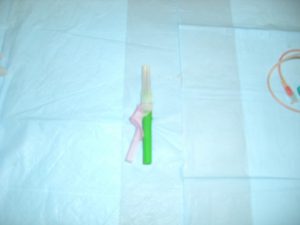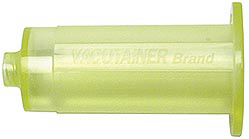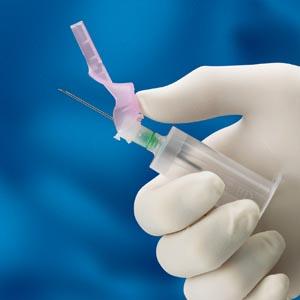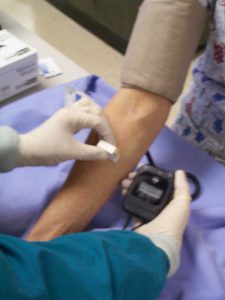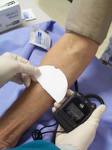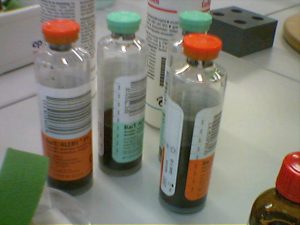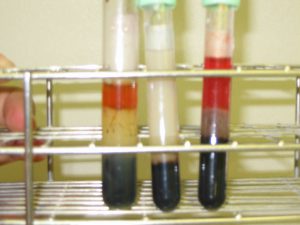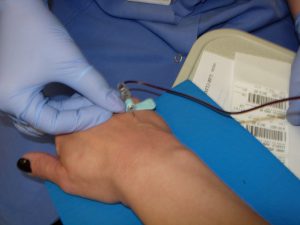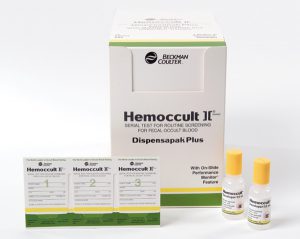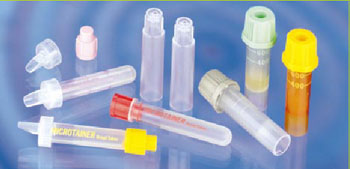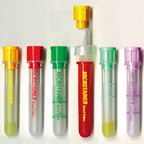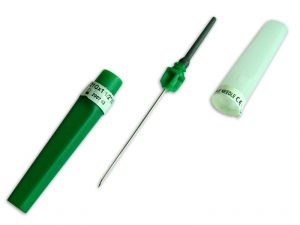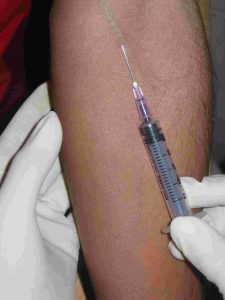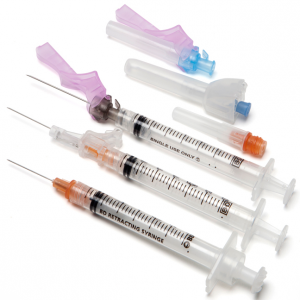PLAB 1323: Phlebotomy

-
- Dates: January 20- March 15, 2026
- Length of Course: 8 Weeks
- Total Number of Hours: 96
The profession of phlebotomy is taught through didactic, student laboratory, and clinical experiences. The student will be trained to perform a variety of blood collection methods using proper techniques and precautions including: vacuum collection devices, syringes, capillary skin puncture, butterfly needles and blood culture specimen collection on adults, children and infants. Emphasis will be placed on infection prevention, proper patient identification, proper labeling of specimens, and quality assurance. Students will be taught specimen handling, processing and accessioning. Students will learn the theory and principles of CLIA waived laboratory tests and perform the tests in the student laboratory. The testing performed will include: manual hematocrits, Urinalysis dipsticks, fecal occult blood, erythrocyte sedimentation rate and pregnancy testing.
Upon successful completion of this course, the student should be able to:
- Identify components of the health care delivery system and the services each provides;
- Identify each department within the laboratory, list tests, and corresponding pathologic conditions associated with each department;
- Apply knowledge of infection control and safety in the workplace;
- Demonstrate basic understanding of the anatomy and physiology of body systems and anatomic terminology;
- Utilize computers, information systems and other technology as related to job duties and responsibilities;
- Demonstrate basic understanding of age specific or psycho‐social considerations involved in the performance of phlebotomy procedures on various age groups of patients;
- Demonstrate understanding of the importance of specimen collection and specimen integrity in the delivery of patient care;
- Identify and report potential pre-analytical errors that may occur during specimen collection, labeling, transporting and processing;
- Demonstrate knowledge of phlebotomy collection equipment, various types of additives used, special precautions necessary and substances that can interfere in clinical analysis of blood constituents;
- Perform standard operating procedures to collect specimens via venipuncture and capillary (dermal) puncture;
- Explain the collection of non-blood specimens, such as urine, stool, sputum, throat or others in order to instruct patients, process and handle non-blood specimens;
- Perform specimen requisitioning and processing;
- Transport specimens following safety regulations, predetermined criteria, and standard protocol;
- Explain quality assurance and quality control in phlebotomy;
- Communicate professionally (verbally and nonverbally) in the workplace;
- Perform waived and POCT procedures as established using standard protocol and predetermined criteria for testing and quality assurance;
- To promote diversity and cultural sensitivity among students and faculty in preparation for clinical practice.
Please print the PLAB 1323 Syllabus and bring it to class.
RECOMMENDED: Phlebotomy Handbook: Blood Specimen Collection from Basic to Advanced, 10th Ed. Becan-McBride, Kathleen. Pearson. (ISBN 0-13-470932-2).
Specific chapter readings for both lecture and lab can be found in the PLAB 1323/1023 BlackBoard course under the Textbook Readings button.
| Exam 1 Review Quiz (Online) |
The corresponding review quiz must be completed with a score of 80% or better before you are allowed to access to the Exam. |
Opens: Friday, January 23, 2026 7 a.m. |
Closes: 8:30 a.m. |
|
Exam 1 Online |
Covers Lectures: Phlebotomy & Health Care, Infection Control, and Quality Assurance Labs: Infection Control & Venipuncture- Using Vacuum Blood Collection |
Opens 7 a.m. |
Closes 7 p.m. |
| Exam 2 Review Quiz (Online) | The corresponding review quiz must be completed with a score of 80% or better before you are allowed to access to the Exam. |
Opens: Friday, January 30, 2026 7 a.m. |
Closes: 8:30 a.m. |
|
Exam 2 On Campus |
Covers Lectures: Anatomy & Physiology of Organ Systems, Circulatory Systems, Point of Care Testing & Collection, and Safety & First Aid Labs: Venipuncture- Using Vacuum Blood Collection, Capillary Collection, Point of Care Glucose, Point of Care Hemoglobin |
Opens 8:30-10:00 a.m. EVC: Room 9209 CYP: Room: 2121.7 |
Closes Wednesday, February 11, 2026 8:30-10:00 a.m. . |
| Exam 3 Review Quiz (Online) | The corresponding review quiz must be completed with a score of 80% or better before you are allowed to access to the Exam. |
Opens: 7 a.m. |
Closes: 8:30 a.m. |
|
Exam 3 On Campus |
Covers Lectures: Documentation & Transportation, General Considerations in Blood Collections, Complications in Blood Collections, and Pediatric/Geriatric Collections Labs: Venipuncture, Capillary Collection, Communication Skills, Specimen Processing, Winged Collection- Butterfly, and Blood Culture Collection- Syringe |
Opens Wednesday, February 25, 2026 8:30-10:00 a.m. EVC: Room 9209 CYP: Room: 2121.7 |
Closes Wednesday, February 25, 2026 8:30-10:00 a.m. |
|
Exam 4 Review Quiz (Online) |
The corresponding review quiz must be completed with a score of 80% or better before you are allowed to access to the Exam. |
Opens: 7 a.m. |
Closes: 8:30 a.m. |
|
Exam 4 On Campus |
Covers Lectures: Special Collections, Non-Blood Specimens, Chain of Custody Collections, and Legal Issues Labs: Venipuncture, Capillary Collections, Pregnancy Testing (HCG), Urine Collections & Waived Testing, and Fecal Occult Blood |
Opens: 8:30-10:00 a.m. EVC: Room 9209 CYP: Room: 2121.7 |
Closes: Wednesday, March 4, 2026 8:30-10:00 a.m. |
|
Practical Exam On Campus |
Covers all labs |
Opens: Friday, March 6, 2026 8:30-10:30 a.m. EVC: Room 8310 CYP: Room: 2121.7 |
Closes: Friday, March 6, 2026 8:30-10:30 a.m. |
| FINAL Exam On Campus |
Covers all course material |
Friday, March 13, 2026 8:30-10:45 a.m. EVC: Room 8310 CYP: Room: 2121.7 |
Closes: Friday, March 13, 2026 8:30-10:45 a.m. |
Wednesday 1/21
| Lecture Topic |
|
| Laboratory |
|
| Assignment |
|
Friday 1/23
| Topic |
|
| Laboratory |
|
| Assignment |
|
Wednesday 1/28
| Lecture Topics |
|
| Laboratory |
|
| Assignment |
|
Friday 1/30
| Lecture Topics |
|
| Laboratory |
|
| Assignment |
|
Wednesday 2/4
| Lecture Topics |
|
| Laboratory |
|
| Assignment |
|
Friday 2/6
| Lecture Topics |
|
| Laboratory |
|
| Assignment |
|
Wednesday 2/11
| Topic |
|
| Laboratory |
|
| Assignment |
|
Friday 2/13
| Topic |
|
| Laboratory |
|
| Assignment |
|
Wednesday 2/18
| Lecture Topics |
|
| Laboratory |
|
| Assignment |
|
Friday 2/20
| Lecture Topics |
|
| Laboratory |
|
| Assignment |
|
Wednesday 2/25
| Lecture Topics |
|
| Laboratory |
|
| Assignment |
|
Friday 2/27
| Lecture Topics |
|
| Laboratory |
|
| Assignment |
|
Wednesday 3/4
| Lecture Topics |
|
| Laboratory |
|
| Assignment |
|
Friday 3/6
| Topic |
|
| Laboratory |
|
| Assignment |
|
Wednesday 3/11
| Topic |
|
| Laboratory |
|
| Assignment |
|
Friday 10/17
| Topic |
|
| Laboratory |
|
| Assignment |
|
Friday 0/0
| Topic |
|
| Laboratory |
|
| Assignment |
|
Friday x/x
| Topic |
|
| Laboratory |
|
| Assignment |
|
Monday xx
| Topic |
|
| Laboratory |
|
| Assignment |
|
BD Vacutainer® Eclipse
The BD Vacutainer® Eclipse blood collection system is composed of a multi-sample vacuum collection needle and a disposable tube holder. The product can be purchased as individual components or preassembled, as it appears in the third picture. Note the needle safety device is directly attached to the needle. When the phlebotomy procedure is complete, the safety device is activated with the thumb.
Bleeding time test
The pictures below illustrate the performance of the bleeding time test which is used in conjunction with other coagulation tests, such as the prothrombin time, in the evaluation of a patient suspected of having a bleeding disorder. A patient’s bleeding time is a measure of the number of platelets, how well they function, and the ability of the capillary blood vessel wall to constrict (sometimes referred to as capillary integrity). The procedure requires a blood pressure cuff inflated to 40 mm/Hg, and using a bleeding time lancet to make a standardized incision. A filter paper is used to pull the blood away from the incision allowing the technician to view the wound. A stop watch is used to record the amount of time required for the bleeding to stop.
Blood culture bottles
Blood culture bottles are used to collect blood from patients suspected of having septicemia or bacteremia. Proper preparation of the venipuncture site is crucial in preventing contamination with skin bacteria (causing a false positive). The blood collection site must be aseptically cleansed to produce a sterile site with a product such as a Chlorascrub. To aid in preventing false positives, the phlebotomist cannot repalpate or touch the venipuncture site after it has been prepared. Not putting a sufficient amount of blood into the bottle(s) and/or not drawing the blood at the correct time could result in a false negative.
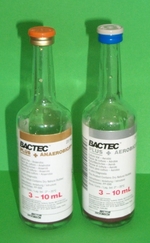
BACTEC blood culture bottles (BMS Diagnostics)
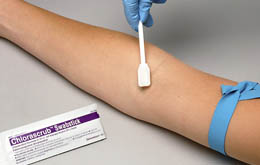
Chlorascrub Swabstick contains 2% chlorhexidine gluconate and 70% isopropyl alcohol.
Blood samples
- Samples that are icteric, lipemic, or hemolyzed often produce erronous laboratory results.
- Left: The Icteric sample. A patient whose blood sample is icteric will have a greatly increased bilirubin which is most often an indication of liver disease or damage. The increased bilirubin causes the patient to be “jaundiced”. Icteric samples are bright golden yellow to orange brown in color depending on the bilirubin level. An icteric sample is very likely to produce erroneous lab results, however, it is not possible for the phlebotomist to avoid or prevent drawing an icteric sample.
- Center: The Lipemic sample. Lipemia (fats in the blood) usually indicates the patient was not fasting when the specimen was drawn. The phlebotomist should re-collect the specimen when the patient is fasting. In very rare cases, the patient may have a hereditary lipidemia (hyperlipidemia), and recollection of the sample will not improve the sample’s quality.
- Right: The Hemolyzed sample. The picture on the right indicates significant hemolysis of the specimen. Hemolysis is most commonly due to the red blood cells rupturing due to a traumatic draw, such as pulling too hard on the plunger of the syringe, drawing blood through a needle that is too small, or blood being forcefully pulled into a tube.
Butterfly (Winged Collection Set) needles
Fecal occult blood test
The fecal occult blood test is primarily used to screen for colorectal cancer by detecting “occult” or hidden blood in the stool sample. The cards in the test pack contain a special guiac paper which reacts with the heme portion of blood to cause a blue color to appear when the developer is added. The product shown below is Hemoccult II®.
HemoPoint® H2 Meter
Hemoglobin and Hematocrit point of care instrument provides fast, easy and accurate results for both hemoglobin and hematocrit on blood obtained from a capillary puncture.
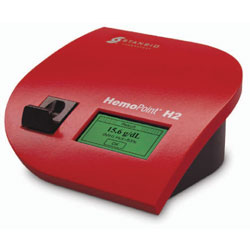
Lancets
Lancets are used for capillary blood sampling and come in a wide variety of shapes and sizes. Modern blood lancets are safety engineered, self-contained, single use automated puncture devices designed to produce a uniform puncture of a specified depth. Punctures are routinely made on the side and near the tip of the 3rd or 4th finger of adult and pediatric patients. Capillary blood is collected from the sides of the heel of non-walking infants. It is critically important the heel stick is performed in the correct area of the heel to prevent nerve or bone damage.
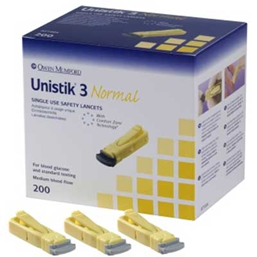
Owen Mumford Unistik 3
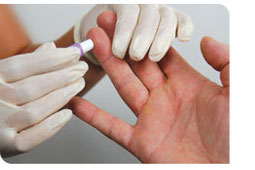

Microcapillary tubes
Microcapillary tubes are used to collect small volumes of blood. The tubes have a ring / tip color to indicate any additive. Color coding is as follows: red tip = sodium heparin, green tip = ammonium heparin, and blue tip = plain/no additive. The most common test using the microcapillary tube is the hematocrit (a part of the CBC) which is routinely collected in the red tipped tube.

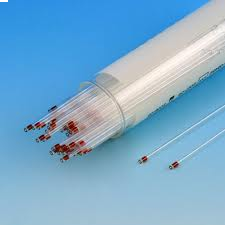
Microtainer®
Microtainer® microcollecion tubes are used to collect blood from a skin puncture (heel or finger). Collecting this type of sample should be considered for patients who are difficult draws such as elderly patients with fragile veins, infants, small children and other patients with difficult veins. This can only be done for tests which can be performed on small quantities of blood. List 3 tests which cannot be performed on blood from a capillary puncture.
Multi-sample blood collection needle
This device has two needles. The needle is screwed into the holder. One needle is inserted into the vein, the vacuum blood collection tube is inserted into the holder and is punctured by a needle on the opposite end. The rubber sheath allows multiple tubes of blood to be collected and covers the needle in between tube changes so blood does not collect in the holder.
Portex Needle-Pro
The Portex Needle-Pro (Jelco® Venipuncture Needle-Pro® Safety Device) is a needle safety device used with the vacuum tube blood collection system. Note, this blood collection device uses a standard multi-sample collection needle, as seen in the first photo. The needle safety device is activated by pressing it against a hard surface to permanently cover the needle.
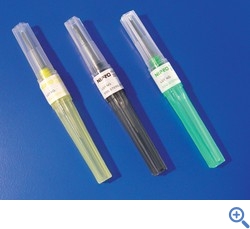


Syringe with a syringe needle
A syringe with a syringe needle is sometimes used to collect blood from patients with difficult, small or fragile veins. Collecting with a syringe and needle is especially useful when the phlebotomist needs to control the amount of vacuum being applied to prevent or reduce the chance of the vein collapsing.
Tourniquets
Tourniquets are used to stop the flow of venous blood and make the veins more prominent. A latex free tourniquet must be used on patients who have latex allergy.
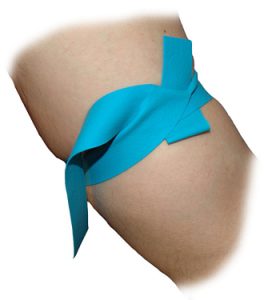
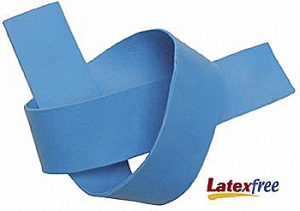
Transfer pipets
Transfer pipets are used to transfer serum or plasma into other tubes for testing. The transfer tube must be properly labeled using information from the original sample tube before placing the sample in it.

Urine dipsticks
Urine dipsticks are used for the chemical examination of urine. The product shown below is the Multistix® 10 SG reagent strip.
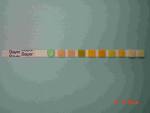
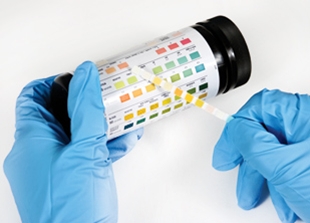
Vacutainer® blood transfer devices
Vacutainer® blood transfer devices are used to protect the phlebotomist from an accidental needle stick when transferring blood from a syringe to the vacuum tubes. The syringe is attached to the top of the device, the tubes are then inserted into the holder until the stopper is punctured by the needle inside the holder. The vacuum in the tube causes blood to be drawn into the tube.



Search the Health Sciences Website
Phlebotomy Technician Updates
ACC and AFD Celebrate Five Years of Red Angels Partnership
A new plaque proudly hangs on the walls of ACC’s Health Sciences building at Eastview Campus — celebrating five years of making a difference in the community.
Read moreTEAS Testing Requirements for Health Sciences Applicants
A TEAS Exam score is required to apply to the following programs: Dental Hygiene, Occupational Therapy Assistant, Radiology, and Vocational Nursing.
If you are not applying to one of the programs above, then you are not required to take the TEAS Exam at this time. Please refer to the Application Process page for your program to see all application requirements.
Read moreOnline Application Submission Process
Due to public safety concerns, applications will not be accepted in person until further notice. Effective immediately, applicants for all Health Sciences programs except Associate Degree Nursing, Mobility Nursing, and RN-to-BSN should follow these instructions when submitting their application and supporting documents:
Read more


